How often have you thought about creating a website, but just weren’t sure where to begin?Creating a website is a fundamental step for establishing your online presence. Our beginner’s guide on how to create a website offers clear, step-by-step instructions to help you get started effectively. Whether you’re a novice or have some experience, this guide covers everything from domain registration to website launch, ensuring you can create a professional site tailored to your needs. Discover the essential tools and techniques required to bring your online vision to life with confidence.

Building a website is easier than you might think, and we cover the entire process, step-by-step, in this tutorial.
If you’re ready to design a website and create a new online presence—for yourself, your business, or a side project—today is the day.
- How Long Does It Take to Create a Website?
- How To Create A Website: Video Tutorial
- Step 1: Choose A Platform to Create a Website
- Step 2: Get A Domain Name & Hosting Account to Create a Website
- Step 3: Set Up WordPress On Bluehost to Create a Website
- Step 4: Log Into Your WordPress Dashboard
- Step 5: Customize Your Basic Site Settings
- Step 6: Install A WordPress Theme
- Step 7: Customize Your Theme
- Step 8: Add Content To Your Website
- Step 9: Customize Your Sidebar & Widget Areas
- Step 10: Install Plugins For Added Functionality
- How to Populate Your WordPress Website with Engaging Content
- Build A Website: How Do Website Owners Get Paid?
- Enhancing Your Website with Blogging and eCommerce Features
- How to Install WordPress Using cPanel’s WordPress Onboarding Flow
- Create A Website: Frequently Asked Questions
- How to Conduct a Final Review and Create Your WordPress Website
- How to Publish Your Website: Create a Website Once It’s Ready for Launch
In this guide, you’ll learn how to create a beautiful website quickly and easily, without having to learn HTML/CSS and without writing a single line of code.
You’ll also learn how to avoid some of the unnecessary costs of building a website. You don’t need an expensive website builder!
This comes from our experience building dozens of websites over the last 10+ years, including this one! We know what works, and we’re here to walk you through every step of the process to create a website.
There’s a lot of information here—so feel free to bookmark this page and return to it as you move through the steps.
And of course, if you have any questions along the way, just leave a comment below this article and we’ll do our best to help you out. 🙂
Sound good? Let’s dive in and start to create a website!
How Long Does It Take to Create a Website?
Understanding the time it takes to create a website involves considering several key factors. Let’s break down what influences the development time:
- Platform Selection: The choice of platform sets the initial pace; some platforms offer rapid deployment, while others, built for bespoke needs, may require more setup time.
- Website Complexity: The complexity of your website is pivotal. A straightforward site with a few pagesIn WordPress, a page is a content type that is used to create non-dynamic pages on a website. Pages are typica... More will naturally take less time than a comprehensive enterprise site with intricate functionalities.
- Tools for Efficiency: Efficiency tools play a crucial role. Modern website builders, for example, can have a basic site up and running in under an hour, streamlining the process significantly.
- Customization Time: Customization adds another layer. Projects needing unique features tailored to specific needs extend development timelines, often taking days or weeks to complete.
In summary, website development timelines can vary widely, ranging from as little as an hour for basic setups to several days or longer for complex, customized projects that align closely with your specific vision.
How To Create A Website: Video Tutorial
Prefer to watch instead of reading? We’ve converted this entire guide to a video on our YouTube channel:
(Click here for the discount mentioned in the video.)
If you prefer text, read on! Each step to create a website is covered in detail below.
Step 1: Choose A Platform to Create a Website
There are so many different platforms and website builders out there, and choosing the right one can feel a bit overwhelming.
WordPress, Drupal, Squarespace, Joomla, and Wix are just a few examples.
(You could also code a website yourself from scratch, but that would take much longer, and you probably wouldn’t love the end result.)
So which website builder should you use to create your website?
Well, let’s take a look at what other people are using.
The Most Popular Website Builders
According to BuiltWith, here’s a breakdown of website builders by market share:
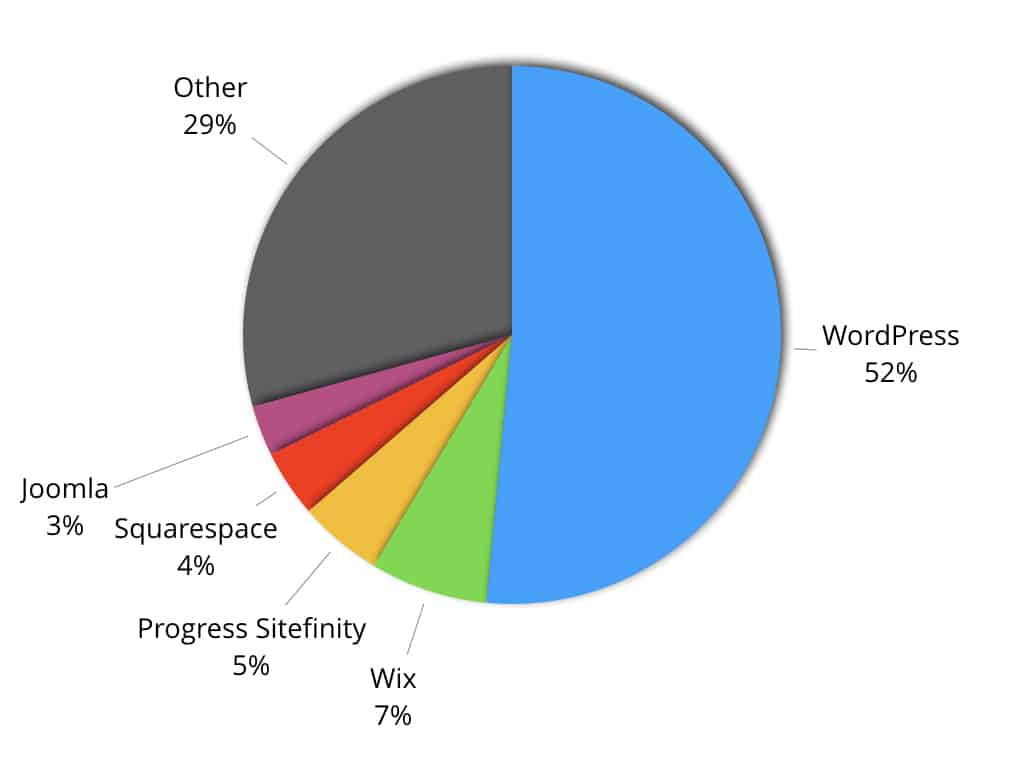
As you can see, WordPress leads the pack with a solid 52% of the market, followed by Wix (7%), Progress Sitefinity (5%), Squarespace (4%), and Joomla (3%).
Why We Recommend WordPress To Create Website
It’s no coincidence that WordPress holds such a strong lead—it offers a number of advantages over other website builders.
If you’re just getting started, we strongly suggest going with WordPress.
With that said, you can always change your mind later! Most web hosting services offer one-click installations for a variety of website builders, including WordPress, Joomla, and Drupal—which are all free.
Step 2: Get A Domain Name & Hosting Account to Create a Website
Before you can start to create your website, you’ll need a domain name and a web hosting account.
This isn’t as complex or technical as it may sound. It’s just a matter of following a few simple steps.
You can get both your domain name and your web hosting account from Bluehost, which is one of the most popular web hosting providers in the industry (and officially recommended by WordPress.org).
By using the link below, you can get more than 50% off the regular price and get your domain name included for free:
—> Click here to head over to Bluehost and pick your hosting plan:
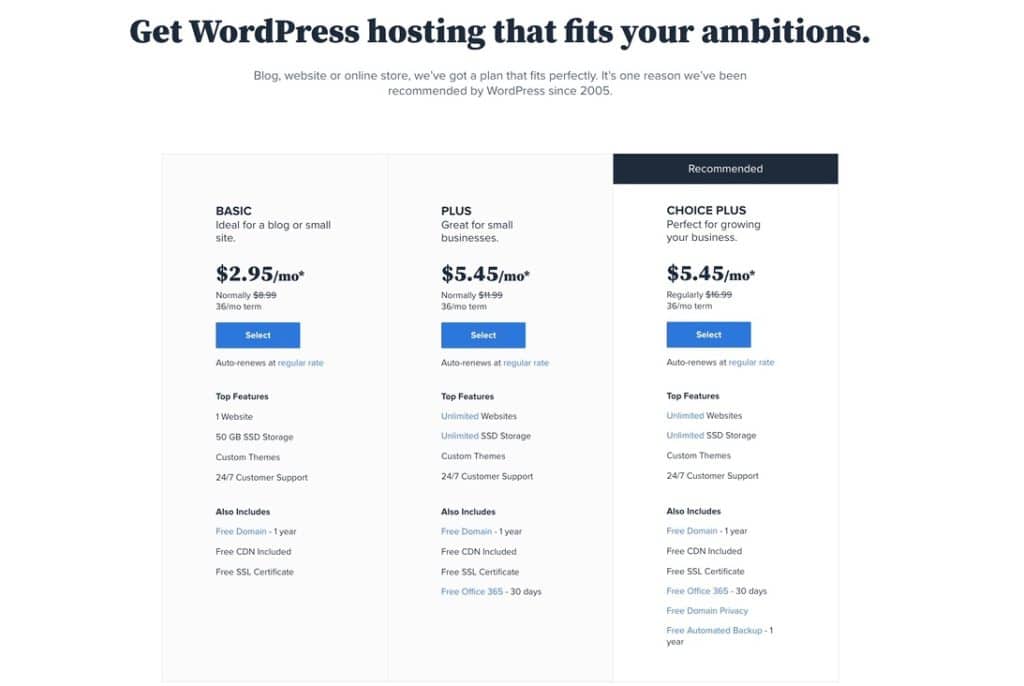
Which Hosting Plan Is Right For You To Create Website?
Bluehost has three main hosting plans: Basic, Plus, and Choice Plus.
🤔 Not sure which plan to choose?
If you want to keep your costs as low as possible and only need to create one website, go with Basic. If you need multiple sites or want the benefits of additional storage, domain privacy, and free automated backups, go with Choice Plus. The discounted prices are actually the same for both Plus and Choice Plus, so there is currently no compelling reason to choose the Plus plan.
Go ahead and click the Select button on your preferred plan to get started.
Create A Website: Choosing Your Domain Name
On the next page, you can register a domain name for your new website:
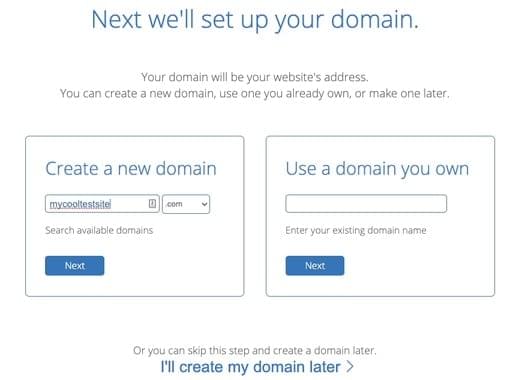
This is where people will find your site on the web—for example, yoursite.com.
And remember, since you used the discount link above, this is included for free with your hosting package! (Domain names usually cost anywhere from $15-30 per year to register.)
How To Choose A Good Domain Name
If you haven’t decided on a name for your website yet, here are a few tips:
- Go for
.comif you can. The extension doesn’t really matter, but many people still trust.comand.netthe most. - Make it brandable. This means your domain should be unique, easy to memorize and pronounce, and trustworthy.
- Use only words. Generally, you’ll want to avoid using hyphens, and only use numbers if they’re part of your brand name (for example: 9to5Mac.com).
If you’re having trouble coming up with good ideas that aren’t taken, here’s a process I like to use:
- Make a list of random words related to your topic or niche.
- Run each of those words through Thesaurus.com to get some synonyms, and add those to the list.
- Throw in some other words that aren’t necessarily related to your topic: adjectives, prefixes, suffixes, words you just happen to like, etc.
- Spend some time playing with different combinations of the words on your list to see what works and what doesn’t.
You can also look at other websites in your industry and draw inspiration from them.
If you’re really stuck, you can try using one of these name generators:
Once you’ve decided on a name, go ahead and enter it into the “Create a new domain” box and click Next.
Almost There…
Finally, you’ll need to enter some information to create your Bluehost account and process your payment:

You’ll notice that you have the option of choosing a billing period from 12 to 36 months.
Important Note: The discounted price will be locked in for whatever period you choose, after which it will return to the normal retail price. The longer the billing period, the more money you’ll save over time. I would strongly recommend going with a longer billing period if you’re comfortable with the upfront cost.
Toward the bottom of the page, Bluehost will offer you some “Package Extras”:

- I recommend adding Domain Privacy, which ensures that spammers, telemarketers, and random Internet crazies can’t look up your contact info and address in the public domain records. When you add the Domain Privacy service, Bluehost will effectively act as your agent, using their address and contact info in the public records for your domain. (This is included for free with the Choice Plus plan.)
- Codeguard Basic can also be a good investment. This is Bluehost’s automated backup and monitoring service. (Also included for free with the Choice Plus plan.)
- Note that the Microsoft 365 Mailbox trial will charge you after 30 days, so unless you want that service and are willing to pay for it, uncheck that box now or remember to cancel before it renews.
- You don’t need to add Bluehost SEO Tools, SSL, or SiteLock Security.
Once you’re satisfied with your options, you can enter your credit card details (or click “more payment options” to pay with PayPal), agree to the terms of service, and click Submit.

After you’ve done this, simply follow the onscreen instructions to create a username and password for Bluehost and log into your account.
You should also receive an email asking you to click a link to activate your domain name. Make sure you do this!
Step 3: Set Up WordPress On Bluehost to Create a Website
When you log into the Bluehost customer area, you should see a welcome message inviting you to create or migrate your website:

To get started, click Create your website.
At this point, Bluehost will open a wizard to guide you through some of the initial setup stuff.
I actually recommend skipping all of these steps, as shown below. When asked, be sure to select the Limitless Customization option (this will help you more easily follow the rest of this tutorial):
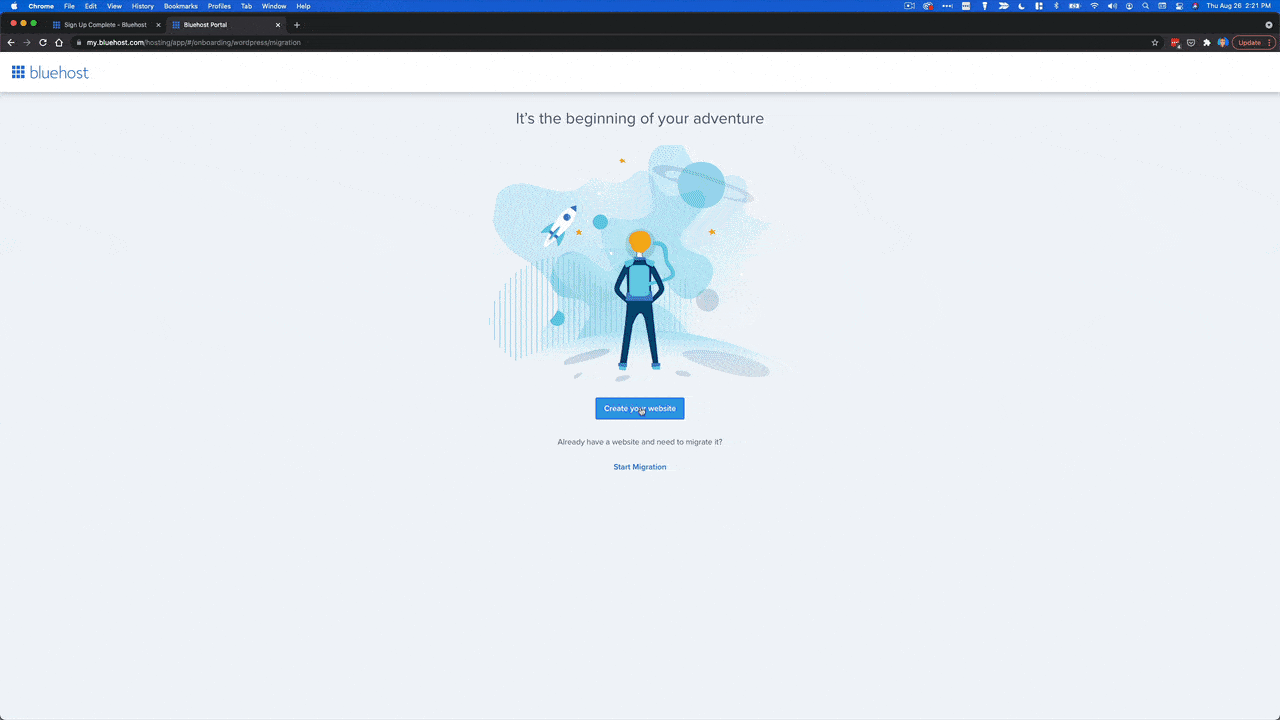
Once you skip through the wizard, you’ll find yourself in the main Bluehost customer area. From here, click Log into WordPress:

This will open the WordPress dashboardIn WordPress, the Dashboard is a central hub for managing a website's content and settings. It is the first sc... More, which is where you’ll manage all aspects of your website, including your blog postsA post is a type of content in WordPress, a popular open-source content management system used for creating an... More, pages, theme/appearance, and more:
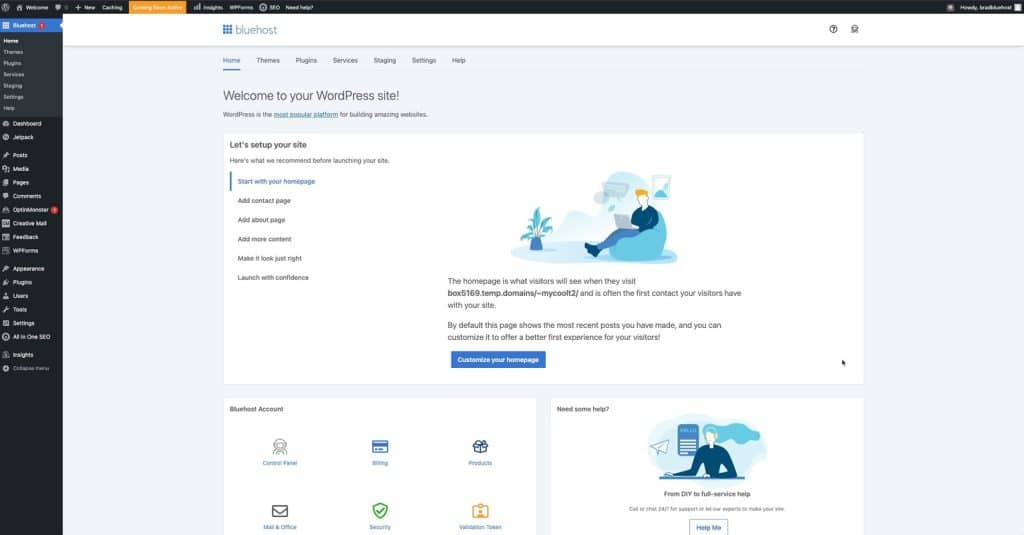
Let’s simplify…
Right away, you may notice that this is a pretty busy interface with lots of things going on.
This is because Bluehost preloads WordPress with a bunch of plugins that you may or may not actually need. Personally, this kind of stresses me out. I prefer to start with a clean slate.
So, before we get into the nitty-gritty of WordPress, let’s get rid of all the stuff that’s been preinstalled so we can build our site from scratch.
First, using the left sidebar menu, hover over the Plugins section and click Installed Plugins.

Next, scroll to the list of plugins and use the check box at the top to select all of them. Then use the Bulk actions drop-down menu to select Deactivate, and click Apply.
Right away, your entire interface should look MUCH cleaner, and it’ll be easier to follow along with this and other WordPress tutorials (because now you’re using the standard WordPress dashboard that you’ll see in most screenshots and videos).
We’ll cover plugins later in this tutorial, and you can decide for yourself which ones you actually want/need.
Set Your WordPress Password
One more quick step to make your life a bit easier: let’s set a password for your WordPress account.
Once you’ve done this, you’ll be able to log into your website directly, without having to go through Bluehost every time.
Using the left sidebar menu, go to Users > Profile.

Scroll down and click Set New Password. Then simply enter a new password, and click Update Profile.
Once you’ve done this, you can access your WordPress dashboard by adding /wp-admin to the end of your domain name, and log in using your email address and the password you just created.
For example, if your domain name was example.com, you would find your WordPress dashboard at example.com/wp-admin.
(Note: if you get some kind of error when trying to visit your website or your WordPress dashboard directly, you probably just need to wait a few minutes for your domain name to finish activating. Once again, make sure you’ve verified your email address.)
🎉 Before we move on, let me be the first to congratulate you…
You just took a major first step. You literally have a live website up and running now. Seriously—open up a new tab and type in your domain name.
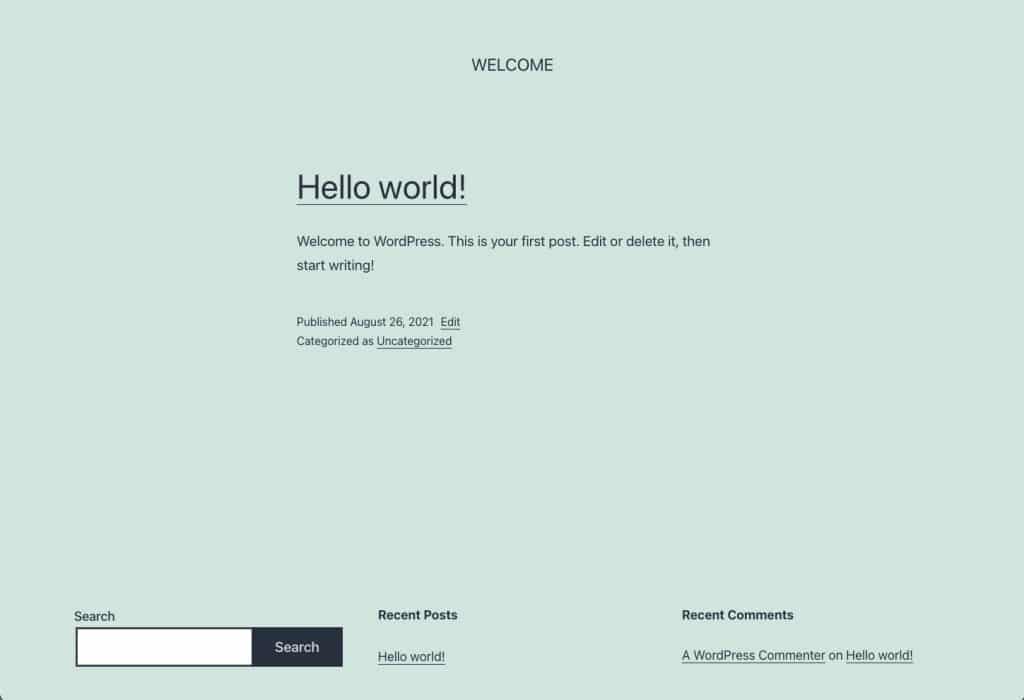
It’s not much yet, but it’s there!
Next up, it’s time to customize your site.
Step 4: Log Into Your WordPress Dashboard
From now on, you’ll be managing your website from your WordPress dashboard.
Once again, you can access your WordPress dashboard by adding /wp-admin to the end of your domain name. For example: yourdomain.com/wp-admin/

If you’re not already logged in, go ahead and log in using your email address and the password you chose in the previous step.

This is where you’ll manage every part of your website, from your theme and appearance to your pages, blog posts, settings, and so on.
At first, you may feel overwhelmed by all the various menusIn WordPress, a menu is a collection of links that are displayed as a navigation menu on a website. Menus are ... More and options—but don’t worry, it doesn’t take long to get comfortable using WordPress.
Here’s a quick overview of the WordPress dashboard and how to navigate it:
Step 5: Customize Your Basic Site Settings
Now that your website is up and running, there are a few basic settings you’ll want to customize to your liking.
Start by navigating to Settings > General in the main WordPress Menu.
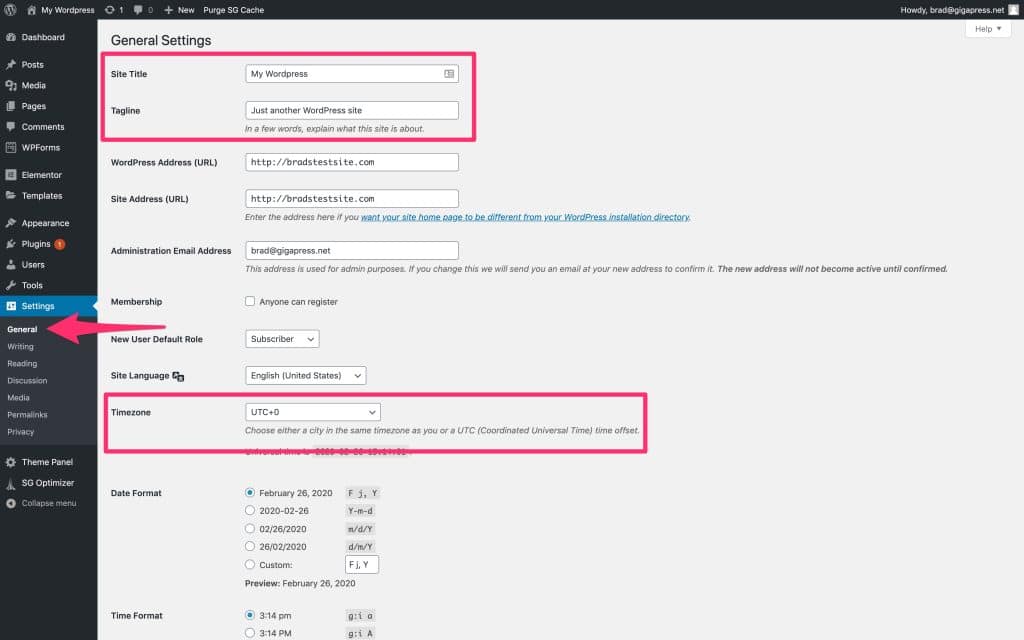
On this page, you can change your site title from the default placeholder.
You can also add a short tagline, which may show up in various places on your site. This is optional—you can just delete the placeholder text if you’re unsure.
Finally, be sure to set the timezone to match your local time.
When you’re happy with these settings, scroll down and click Save Changes.
Step 6: Install A WordPress Theme
Now it’s time to make your website look beautiful.
One of the reasons I love WordPress is because it’s ridiculously easy to customize your website and build something truly unique. That’s made possible by themes.
WordPress themesA WordPress theme is a set of files that determine the design and layout of a website. It controls everything ... More determine how your website looks. They don’t change your content itself (posts pages, etc.), but they do change how that content is displayed on your site.
As an example, you could go from this:

…to this:

…in just a few clicks.
WordPress comes with a default theme that gets an overhaul about once a year. As you’d expect, it’s compatible with most of the things you’d want to do with a WordPress site.
However, I would advise most people not to use the default theme that comes with WordPress. That’s not to say it’s a bad theme—it’s just hard to stand out and brand your business/project if your site looks the same as thousands of others.
So, then, how do you find a good theme for your website?
I’m glad you asked…
Free Themes From WordPress.org
WordPress has a massive community of theme developers, many of whom release their themes for free on WordPress.org.

There are thousands of free themes available, and many of them are quite good.
You can view and install free themes through your own WordPress dashboard by going to Appearance > Themes, and clicking the Add New button at the top:
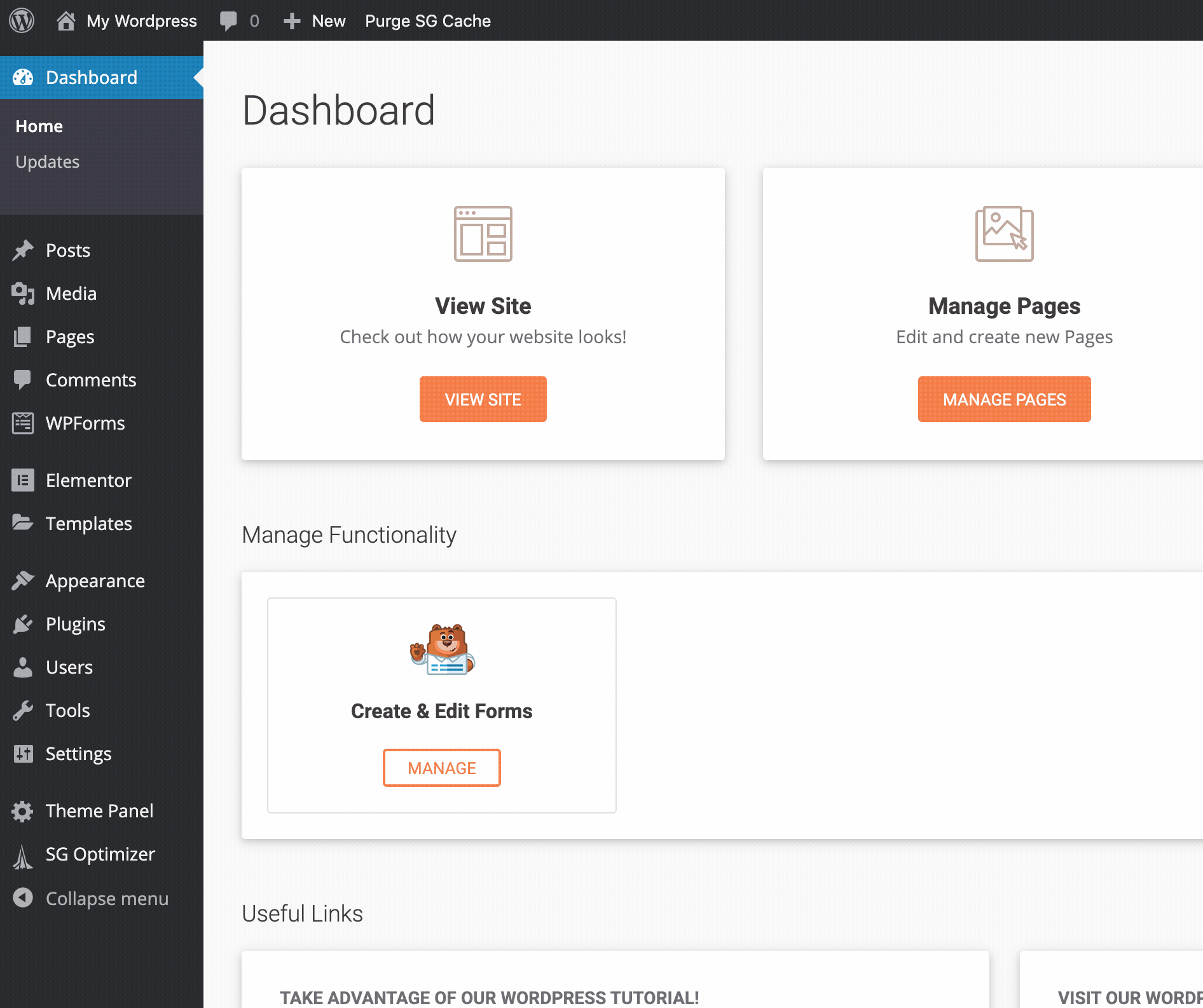
There are themes for just about anything, whether you’re building a business site, a blog, an e-commerce store, or something else entirely.
When you find a theme that piques your interest, you can click on it to see a more detailed description and a rough preview. If you like it, you can click Install to add it to your site, and then Activate to immediately make it your active theme.

(Note that some themes may require a bit of customization before they look exactly like the thumbnail image. More on that below.)
Premium Themes
In addition to the free themes from WordPress.org, there’s a whole world of premium themes that you can buy from third-party sellers and marketplaces.
Again, there’s nothing inherently wrong with free themes, but a premium theme can be a great investment if you want a high-quality design and ongoing support from the developer—which is usually included in the purchase price.
Here are a few of my favorite places to get premium WordPress themes:
- ThemeForest — A huge marketplace where independent developers sell their themes
- StudioPress — One of the most reputable theme vendors in the business
- GeneratePress — A lightning-fast multipurpose theme that can be customized for nearly any purpose (check out their demo sites)
When you purchase a premium theme, it will usually be delivered as a .zip file, which you can install directly through your WordPress dashboard.
Just go to Appearance > Themes, click Add New, and then click Upload Theme:

From there, just upload the .zip file, and you’ll have the option to preview or activate your new theme right away.
Step 7: Customize Your Theme
Chances are, even the best theme won’t look exactly the way you want right out of the box. You’ll need to do some tweaking.
Luckily, WordPress has a great feature where you can customize your site’s appearance while viewing a live preview, so you can see the effects of your changes in real time.
After you’ve chosen a theme, go to Appearance > Customize to open the WordPress customizer.

On this screen, you’ll see a number of appearance options in the left sidebar, with a live preview of your site on the right.
Every theme has its own unique options in the customizer, from typography to colors, layout options, and more. You’ll definitely want to spend some time going through these settings and tweaking them until your site looks just right.
Note: If your site doesn’t have any content yet, it may be hard to visualize exactly how the end result will look. You may want to come back to the customizer later, after you’ve added some posts and pages.
Step 8: Add Content To Your Website
While design is important, the most crucial part of any website is its content.
By default, WordPress supports two main types of content: pages and posts.
Creating A Page
Let’s start by creating a page.
To do this, open up your WordPress dashboard and go to Pages > Add New.
You’ll see a content editor that looks something like this:
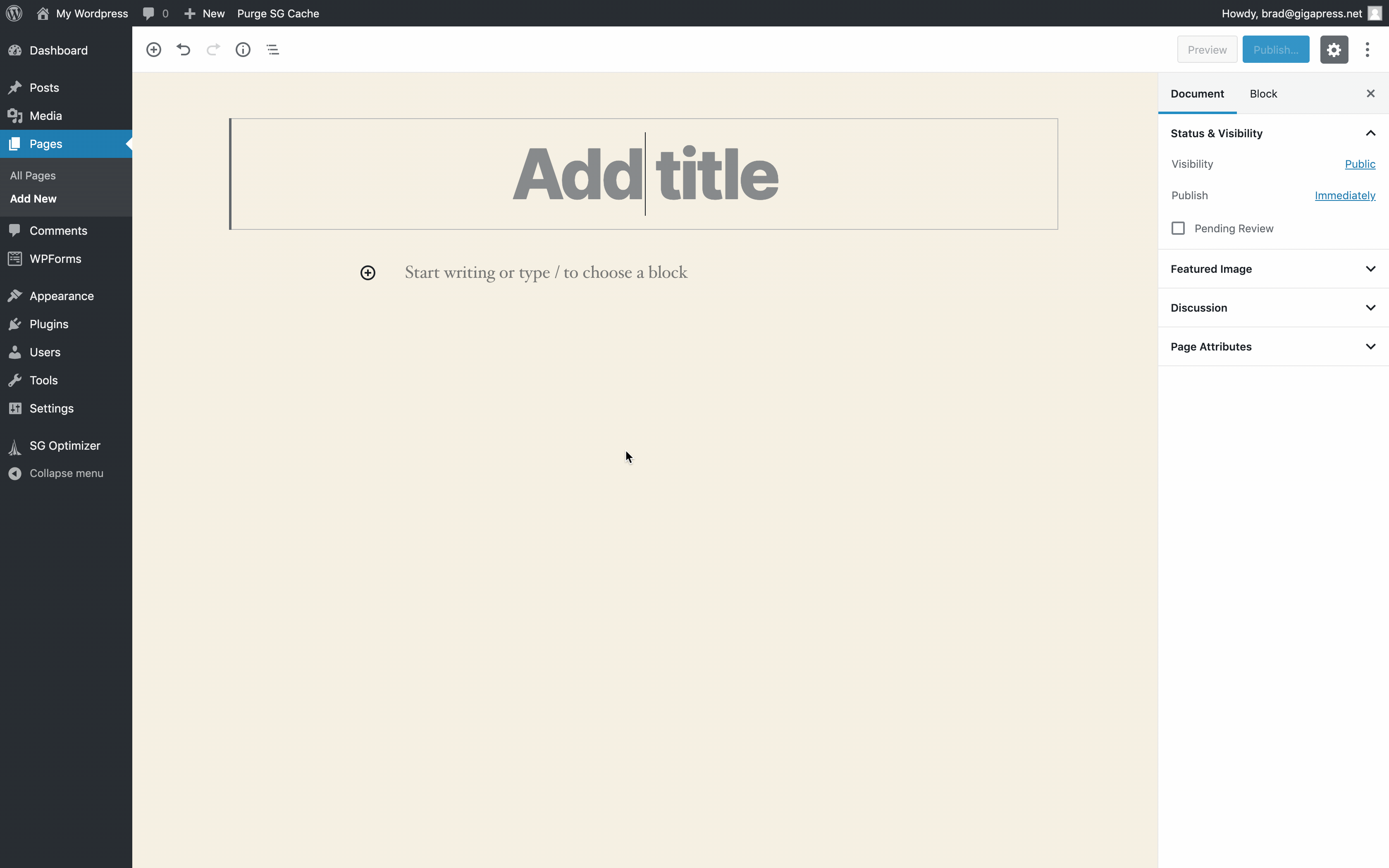
It may look slightly different depending on your theme, but the functionality is the same.
Go ahead and enter a page title and some content. It doesn’t have to be perfect yet—you can always edit it later.
The editor divides your content into “blocks,” which are basically little chunks of content like paragraphs, headings, images, tables, etc.
By default, every time you press enter/return, a new paragraph block will be created. This is exactly like writing in any other text editor.
However, if you’d like to add some other type of content, such as a heading or an image, you can click the + icon to choose a different block:

Notice that the sidebar on the right side provides various options for each type of block.
The sidebar also has a “Document” tab where you can edit a few settings for the page as a whole:
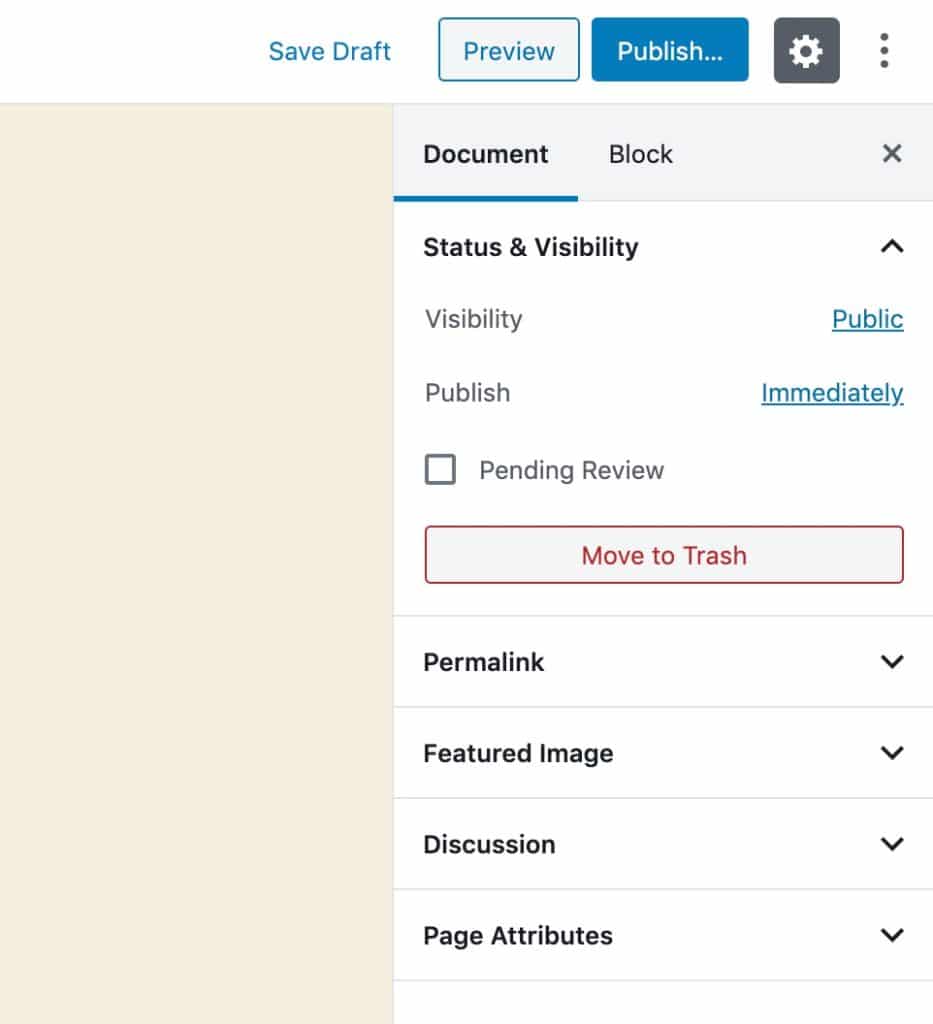
When you’re ready, you can click Publish to publish your page immediately, or Save Draft if you want to come back and finish your work later.
If you click Preview, you’ll see a live preview of what this page will look like on your website.
You can view and edit your existing pages at any time by going to Pages > All Pages.
Creating A Menu
Once you’ve created one or more pages, you may want to add them to your site’s navigation menu.
You can manage your menus by going to Appearance > Menus in your WordPress dashboard.
From there, click “create a new menu” and give it a name, then use the options on the left to add whatever items you want:
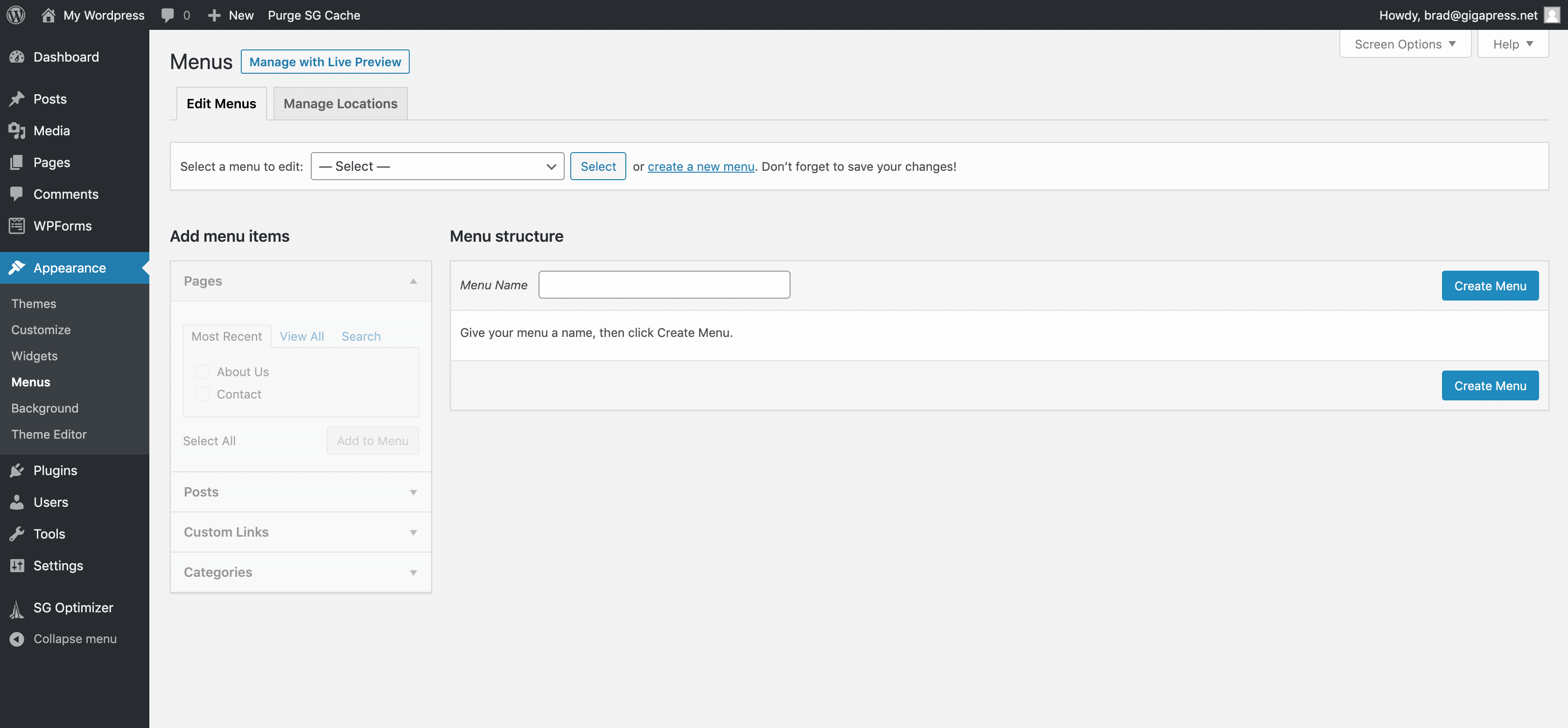
You can also edit the display labels of any pages you add to the menu.
Once you’ve added some pages to your menu, be sure to select at least one “Display location” at the bottom. This determines where the menu will actually appear on your website.
Creating A Post
The process of creating a post is very similar to creating a page.
Go to Posts > Add New to create your first blog post.
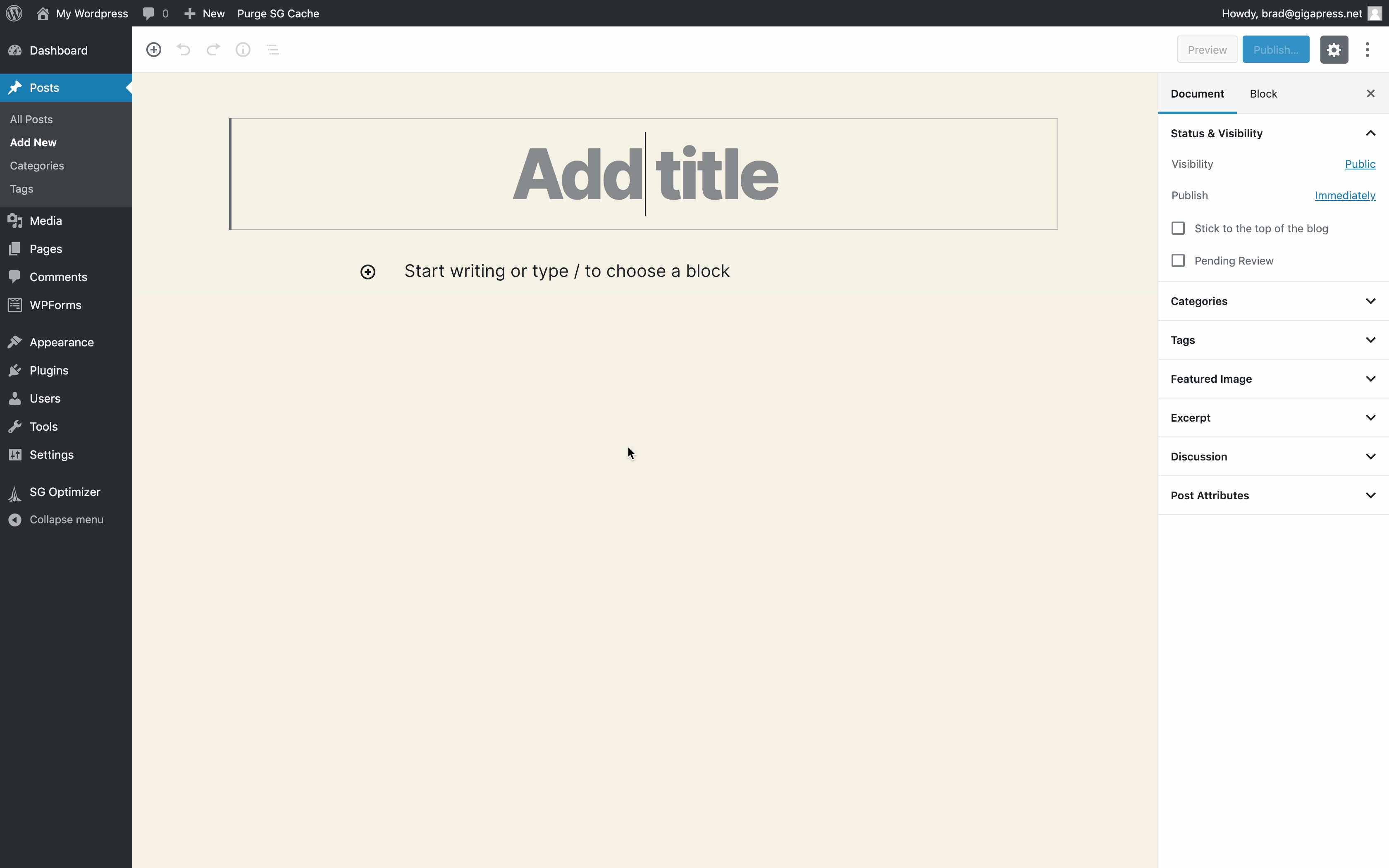
As you can see, the post editor is nearly identical to the page editor.
The main difference is that you have the option to add categories and tags, which are used to organize your blog posts by topic.
See also: How To Start A Successful Blog: The Definitive Guide
This is our all-inclusive blogging tutorial where we discuss not just how to build a website, but how to create amazing content, drive traffic, and make money. 📈
Setting A Static Front Page
By default, your website’s homepage will show your latest blog posts in reverse-chronological order.
If you would prefer to have more control over what people see when they first land on your site, you can opt to use a static homepage instead.
To do this, you’ll need to create two new pages:
- A homepage — This will be your actual custom homepage. Feel free to customize it however you like.
- A blog page — Because your homepage will no longer show your blog posts, you’ll want to create a separate blog page. You can simply create a blank page and title it “Blog” or something similar.
Then go to Settings > Reading in your WordPress dashboard:
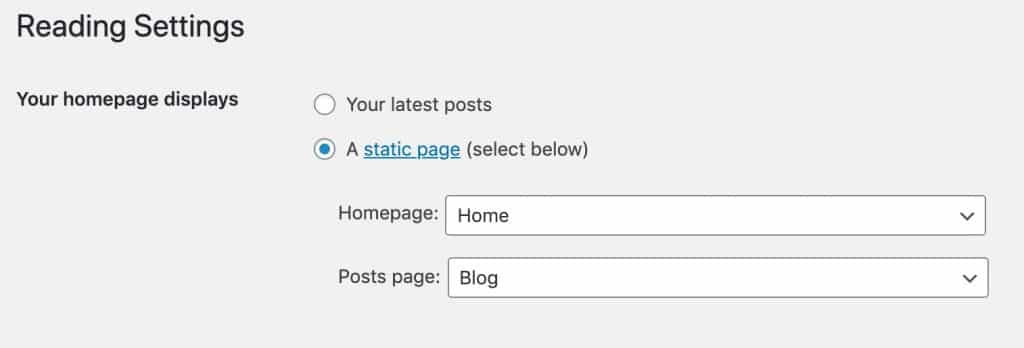
In the section that says “Your homepage displays,” select “A static page.”
Then specify the homepage and blog page that you just created, and save your changes.
Once you’ve done this, your custom homepage will be the front page of your website, and the blank “Blog” page will now display your latest blog posts.
For some more tips on how to do this properly, check out our article on How To Edit Your Homepage In WordPress.
Step 9: Customize Your Sidebar & Widget Areas
If your WordPress theme has a sidebar, you can customize what shows up there by using “widgetsA widget is a small block of content that performs a specific function and can be added to certain areas of a ... More.”
Widgets are small blocks of content that perform a specific function, such as displaying your latest posts, archives, social media profiles, a search box, or even just custom text:
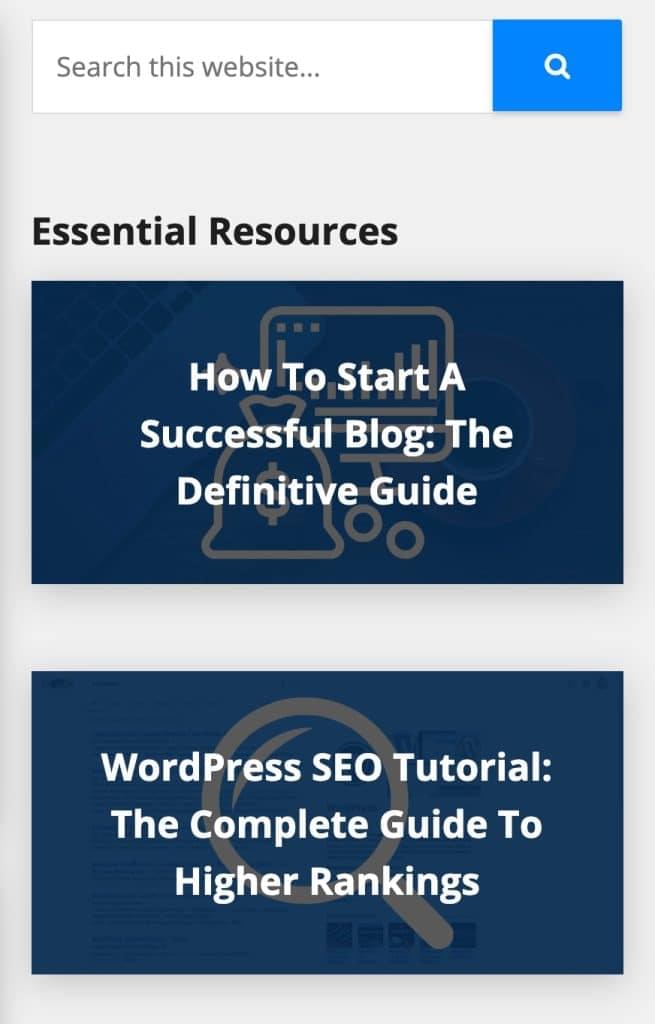
They are most commonly used in sidebars, but many themes also have widget areas in other locations, like the footer.
You can manage your widgets in the WordPress customizer by going to Appearance > Customize and navigating to the “Widgets” section.
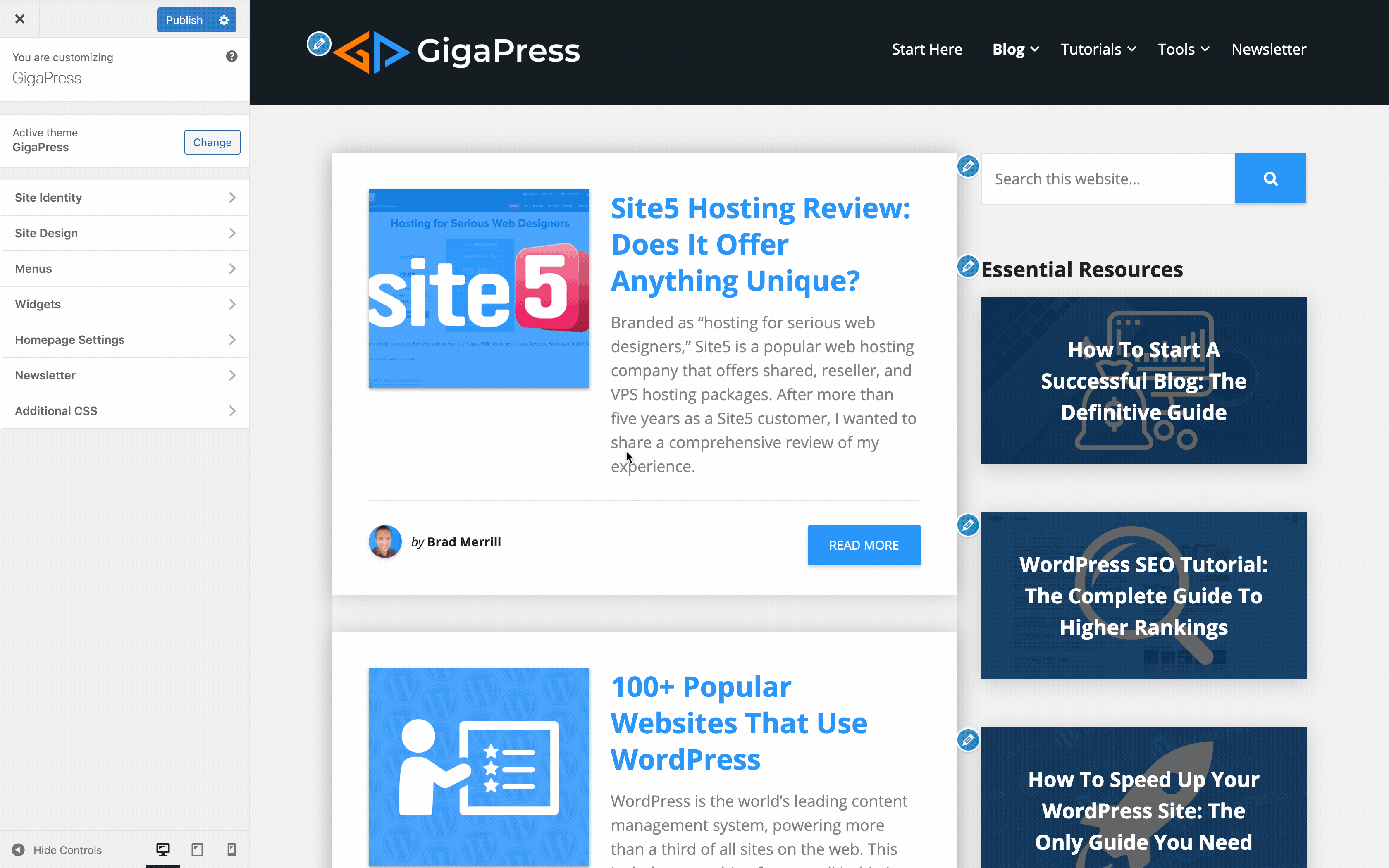
Step 10: Install Plugins For Added Functionality
One of the biggest selling points of WordPress is its extensibility.
With the right plugins, you can make your website do just about anything.
Plugins range in their scope from simple modifications like adding social media buttons to your blog posts, to more complex things like turning your site into a full-fledged social network.
There are tens of thousands of plugins available for free from WordPress.org.
Like themes, you can install plugins directly through your WordPress dashboard, without downloading anything. Just go to Plugins > Add New, and either browse the recommended plugins or search for whatever you need.
To get you started, here are a few plugins we recommend installing:
- Yoast SEO — This pluginA plugin is a software component that adds specific features and functionality to your WordPress website. Esse... More does all sorts of things to make your website more SEO-friendly, to help you rank higher in search engines like Google. (Check out our WordPress SEO tutorial for tips on how to set it up.)
- GA Google Analytics — This plugin makes it super easy to add your Google Analytics tracking code to all pages on your site, so you don’t have to do it manually.
- Contact Form 7 — An easy way to add contact forms to your posts and pages.
After you install and activate a plugin, it will usually add a new link somewhere in your WordPress menu where you can manage its settings.
For example, Yoast SEO adds a new SEO menu:

How to Populate Your WordPress Website with Engaging Content
Creating compelling content on your WordPress site is crucial for attracting and retaining readers. WordPress offers robust blogging features alongside its page creation tools, making it easy to populate your site effectively. Here’s a step-by-step guide and strategies to help you craft engaging content.
Step-by-Step Guide to Creating a Post
- Start a New Post:
- Navigate to ‘Posts’ in your WordPress dashboard and click on ‘Add New’ to open the post editor.
- Craft Your Content:
- Create a captivating title and write your main text. Enhance your post with images, videos, and interactive elements like widgets to keep your audience engaged.
- Organize with Categories and Tags:
- Use categories to group posts into broad themes and tags to highlight specific details within each post.
- Set Visibility and Publishing Options:
- Decide who can view the post by setting a password, keeping it private, or scheduling it for future publication.
- Publish Your Post:
- Once everything is ready, click ‘Publish’ to make your post live on your website.
Tips for Creating Engaging Content
- Quality Over Quantity: Focus on providing valuable information or entertainment with each post.
- Interactive Elements: Incorporate polls, surveys, or interactive videos to boost user engagement.
- Consistent Updates: Keep your content fresh and updated regularly to encourage visitors to return.
For inspiration on effective content presentation, explore successful WordPress websites. Studying well-structured and engaging content examples can offer insights into attracting more traffic and engagement. By following these guidelines, your WordPress site will thrive as a vibrant hub for your audience.
Build A Website: How Do Website Owners Get Paid?
Website owners have multiple avenues to monetize their platforms and generate income. Here’s a detailed exploration of the most common methods:
- Advertising Revenue: Website owners can earn income by displaying ads, often through platforms like Google AdSense. These ads are tailored to match viewer interests and earn revenue when visitors click on them.
- Selling Products and Services: Websites serve as digital storefronts where owners can sell physical goods, digital downloads, or services. Integrated payment gateways ensure smooth transactions for buyers.
- Affiliate Marketing: Owners promote other companies’ products through referral links and earn commissions on each sale. This strategy is ideal for those looking to profit from sales without creating their own products.
- Sponsored Content: Influential websites publish sponsored posts where businesses pay to have their content featured. Transparency is maintained by marking such content as “sponsored”.
By leveraging these strategies, website owners can establish diverse revenue streams based on their content and audience. Successful websites often combine multiple methods to maximize their earning potential, each requiring different levels of involvement and strategic planning.
Enhancing Your Website with Blogging and eCommerce Features
Integrating advanced functionalities like blogging and eCommerce can significantly boost engagement and sales on your website. Here’s a user-friendly guide to adding these features using a typical site creation tool, such as Hostinger.
Adding a Blog: Step-by-Step Guide
- Initialize Your Blog:
- Navigate to the sidebar and click on ‘Pages and navigation,’ then select ‘Add page.’
- Choose ‘Blog’ as your page type and pick a template that matches your style.
- Managing Your Blog:
- Access the ‘Blog’ section from the menu to view drafts, schedule posts, or manage published articles.
- Click ‘Add new post’ to start creating content manually or use AI tools to assist in setting the tone, length, and focus of your post.
- Customizing and Publishing:
- Edit text, insert images, and utilize the toolbar to refine your post.
- Once satisfied, set the post to ‘Public’ to share your content when your site goes live.
For comprehensive blogging tips, explore beginner-friendly guides covering best practices and effective strategies.
Setting Up an eCommerce Store: Step-by-Step Guide
- Enable Your Online Store:
- In the sidebar, navigate to ‘Website settings’ > ‘Online store,’ then click ‘Add store’ to create a new store page with a product list section.
- Managing Your Store:
- Access the ‘Manage store’ option under ‘Online store’ to open the store manager.
- Begin by setting up your store details including name, country, and preferred currency. Click ‘Continue’ to proceed.
- Completing Store Setup:
- Follow the onboarding process to enter the store management area.
- Use the checklist to finalize setup tasks such as product listings and payment method configurations.
For a successful online store, define your business strategy and understand your target audience. Comprehensive tutorials can provide a strong foundation for your eCommerce venture.
By following these steps, you can effectively enrich your website with blogging and eCommerce capabilities, transforming it into a dynamic platform that engages visitors and drives revenue growth.
How to Install WordPress Using cPanel’s WordPress Onboarding Flow
Installing WordPress is straightforward with cPanel’s intuitive onboarding process. Follow these steps to quickly set up your WordPress site:
Step 1: Initiate WordPress Installation
- Log in to your hosting account and navigate to hPanel.
- Go to the ‘Websites’ section and select ‘Add website’.
- Choose WordPress from the options provided to start the installation process.
Step 2: Configure Your Website
- Define the type of website you want (blog, eCommerce, personal, etc.).
- Select your primary language and set up your WordPress login credentials.
Step 3: Skip Plugin Installation
- Initially skip installing plugins to streamline the setup process.
- You can add plugins later based on your site’s specific needs.
Step 4: Select a Theme
- Browse through available WordPress themes and use the ‘Preview’ feature to visualize how they look.
- Choose a theme that aligns with your website’s vision and click ‘Select’ to apply it.
Step 5: Utilize AI Assistance
- Take advantage of AI tools in hPanel to simplify setup.
- Enter your brand name and a brief description to personalize initial content creation.
Step 6: Register and Install
- Register a free domain included with your hosting package, if available.
- Complete domain registration and finalize WordPress installation following the prompts.
Step 7: Access Your WordPress Dashboard
- Navigate back to hPanel’s ‘Websites’ section.
- Click on ‘Admin Panel’ next to your new website to access the WordPress dashboard.
Step 8: Set Privacy Settings
- If your website isn’t ready for public viewing, navigate to ‘Settings’ → ‘Reading’ in the WordPress dashboard.
- Check the ‘Search engine visibility’ option to prevent search engines from indexing your site temporarily.
By following these steps, you can efficiently set up your WordPress site using hPanel’s user-friendly onboarding flow. Enjoy a hassle-free installation process and get your website up and running quickly.
Create A Website: Frequently Asked Questions
Here are the answers to a few common questions we often hear about creating a website. (Click to expand.)
How much does it cost to build a website?
If you use WordPress, the only required costs are your annual domain registration fee and your web hosting account.
By using this discount link, you can get a web hosting package for as low as $2.95 per month, with a free domain name included. Like most web hosting companies, Bluehost bills annually. However, if you require monthly billing, you can find some alternative options here.
If you choose to purchase a premium WordPress theme, they typically run from $30–70 as a one-time purchase.
All in all, it is completely feasible to build a beautiful, functional website with less than $100 USD invested upfront.
Do I need to know how to code to build a website?
Coding knowledge is not required to build a great website.
Platforms like WordPress have made it incredibly easy for nontechnical people to build websites without writing a single line of code. If you can use a computer, you can build a website with WordPress.
That’s not to say that a little HTML and CSS knowledge won’t come in handy—but believe it or not, those are skills you can pick up organically over time, and they’re certainly not required.
Do I need any special software to build a website?
Nope! You’ll manage everything through your WordPress dashboard, which you can access through your web browser on any device. Just add /wp-admin/ to the end of your domain name.
Can I create a website from my phone?
While we recommend performing the initial setup on a computer, it is certainly possible to do it from a smartphone or tablet.
After you’ve created your website, you can manage your content using the WordPress app for iOS or Android.
Can I keep my website private while I’m still working on it?
Yes! We recommend installing this Coming Soon page plugin, which will ensure that only you can see your site before you’re ready to launch.
Can I add other users to my website?
Yes! If you’d like to give someone else an account to help you with your website, you can do so by going to Users > Add New in your WordPress dashboard.
If you do grant someone else access to your website, be sure to give them an appropriate user roleIn WordPress, a user role is a set of permissions that determines what actions a user can perform on a website... More. You almost never want to give administrator access to another person. Learn more here: WordPress User Roles: Everything You Need To Know
How can I get my website to rank on Google?
Ranking on Google begins with publishing great content, so make sure you’re doing that. Check out our blogging tutorial to learn exactly what that entails.
You’ll also want to install the Yoast SEO plugin, and read our WordPress SEO tutorial for some advanced optimization tips.
To submit your site to Google and monitor your performance in the search results, you’ll want to create an account on Google Search Console.
How can I make money from my website?
Websites make money from a variety of sources, including advertising, e-commerce, affiliate marketing, consulting services, private memberships, and more. We cover all of these in our blogging tutorial here.
How can I add an online store to my website?
If you have products to sell on your website, you’ll want to use the WooCommerce plugin, which integrates full e-commerce functionality into WordPress.
How to Conduct a Final Review and Create Your WordPress Website
To ensure your WordPress website is ready for launch, follow these steps to review and publish it effectively:
Final Review Process
- Preview Your Site: Visit your live site to see how it appears to visitors. Navigate to your WordPress dashboard, click on your site’s name at the upper left corner, and select ‘Visit Site’.
- Check Functionality: Review all elements such as links, forms, images, and functionalities. Ensure everything works smoothly without any issues.
- Review Setup Steps: Return to the WordPress admin dashboard and verify completion of all setup tasks. Navigate through each step to ensure nothing has been overlooked. Prompt links will guide you to complete any pending tasks.
Create And Publishing Your Website
- Adjust Visibility Settings: Go to ‘Settings’ > ‘Reading’ in your dashboard. Uncheck ‘Discourage search engines from indexing this site’ to make your site visible to search engines.
- Go Live: Once satisfied with functionality and appearance, confirm all settings. Your website is now ready to be published and accessible to visitors online.
Following these steps ensures your WordPress website functions smoothly and is optimized for search engine visibility upon launch.
How to Publish Your Website: Create a Website Once It’s Ready for Launch
Publishing your website marks the final step in your development process. Here’s a straightforward guide to help you launch your site effectively:
Step-by-Step Guide to Launch A Website
- Final Checks:
- Proofread all web content thoroughly to eliminate errors.
- Test all website functionalities to ensure they work seamlessly.
- Preview your site across different browsers and mobile devices to ensure consistent appearance and functionality.
- Find the Publish Button:
- Locate the ‘Publish’ or ‘Go Live’ button in your website builder dashboard. It’s usually found in the upper right corner, but this can vary by platform.
- Going Live:
- Click the ‘Publish’ button to initiate the process. It may take a few minutes for your website to go live as the system finalizes settings and publishes your content online.
- Confirmation and Testing:
- Once live, you’ll receive confirmation from your website builder platform.
- Visit your live URL to verify everything functions correctly and appears as expected.
- Announce Your Launch:
- Promote your new website through social media, email newsletters, and other marketing channels to attract visitors.
By following these steps, you can confidently create a website and publish it, ensuring it’s ready to welcome visitors smoothly and professionally.
The Next Steps: Create A Website and Launch It

At this point, we’ve covered all the major steps to create a website, and you’re well on your way to building something great.
Of course, there’s always a learning curve with any new project. Don’t get discouraged if you run into problems! There are plenty of resources here on GigaPress and around the web.
Be patient and keep at it—you’ll master this stuff in no time.
If you have any questions about building a website, or if you run into problems along the way, please feel free to leave a comment below!
If you’re looking for fast wordpress hosting as well as done-for-you updates such as creating a website and establishing your online presence, check out our hosting packages by clicking the button below:



